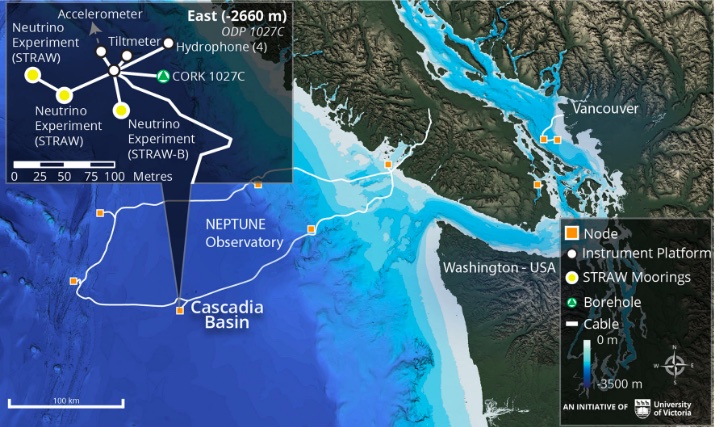The Experimental Site of P-ONE
The site chosen for the construction of P-ONE is the Cascadia Basin in the Pacific Ocean, about 600 km West of Vancouver, Canada. It offers stable operating conditions with sufficient depth (around 2600 m), low currents, a nearly constant 2 ◦C temperature, and good optical properties already explored with the STRAW pathfinder missions. Its most unique feature, however, is the existence of a robust undersea infrastructure run by Ocean Networks Canada (ONC) that is ready for the installation of the P-ONE detector: the North East Pacific Time-series Underwater Networked Experiment (NEPTUNE) Observatory.
Ocean Networks Canada will host P-ONE
Ocean Networks Canada (ONC) operates one of the world's largest and most advanced cabled ocean observatories, of which NEPTUNE is the largest. The NEPTUNE cabled ocean observatory, completed in 2009, is a versatile multidisciplinary subsea system. Its backbone infrastructure comprises an 800-kilometer loop of telecommunication fiber-optic cables to power and transfer data to a variety of sensors. It has been designed for long-lived, highly reliable underwater operations. The high-speed data link and high power are available at five nodes across the Juan de Fuca tectonic plate (200,000 square kilometers) off the coast of British Columbia. Each node acts as a hub for core observations and experiments. 17 primary junction boxes are cabled to the nodes and used to connect hundreds of instruments, including traditional oceanographic sensors, cameras, hydrophones, and other complex systems, including electro-mechanical ones. For P-ONE, the node at Cascadia Basin was chosen. The installation of the detector within the NEPTUNE infrastructure will allow for sequential deployment, easy maintenance, and support from ONC on marine operations.

